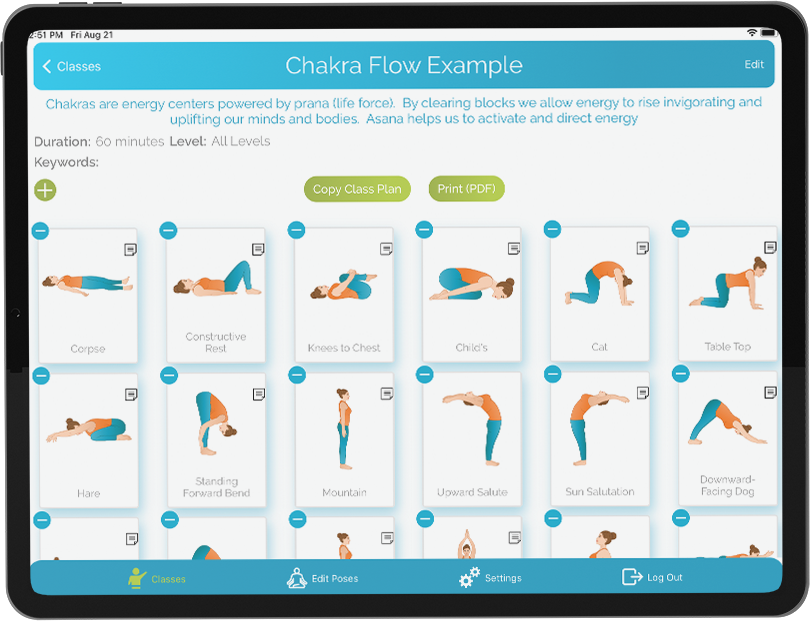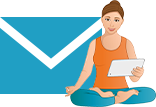Locust Pose
Shalabhasana

STEPS
The main benefits of the locust are to build strength and flexibility in the back. Different traditions have differing ideas of what physically constitutes the ‘locust posture’, shalabhasana. In the ‘Heart of Yoga’, Desikracher identifies five variations of shalabhasana- each of which will change the effect and the function of the asana in different ways. There are also a number of different options as to the breathing whilst entering, leaving and staying in the pose and these themselves are also all able to effect the function and the effect of the asana. Before discussing the benefits and contraindications of this asana it is important to identify with version of the posture is going to be taught
TEACHER QUEUES
VISUALIZATION COMMENTS
Encouraging students to frame their movement with their breath- working in a smooth controlled manner. Using the breath to deepen and soften the asana and work dynamically within shalabhasana. Emphasizing length in the posture- pushing through the heels, rather than lift with help to discourage ‘crunching’ the lower back. If suitable for the students, working with four part breath and breath retention (AK and BK) in the key posture. Opening and closing legs on inhale and exhale and hold on breath retention. Awareness of maintaining breath smoothness important Keep shoulder blades relaxed and on back. Open and inhale into chest- think of a lotus flower opening from the heart centre.
TECHNICAL COMMENTS
Start by lying face down with your lower body relaxed and your feet together and facing down. Hands flat on the floor beneath your shoulders. Without putting weight into the hands, lift the chest and upper body as high as you can and raise the right leg a couple of inches off the ground. It is more important to maintain the hips being level than to raise the foot further off the floor. If this is uncomfortable then folded blankets under the chest or hip area may help. Keep the lower spine neutral and the buttocks active to protect the lumbo-sacral region. Hold for 6 breaths. Lower on the exhale. Repeat on the left leg. The half locust is a preparatory exercise for the full locust, strengthening and helping to warm up the muscles of the back. To enter the full posture ensure the body is relaxed with the legs extended and together and the feet relaxed. The arms are palm down by the side of the body. Using the muscles of the back, raise the chest and the legs simaltaneously on the inhale. As the legs raise up widen the feet. If this feels uncomfortable on the lower back reduce the width of the feet. Maintain this position on AK. On the exhale close the legs, maintaining the leg height and maintain the position with the legs together on the BK. Repeat this for 3 breaths and lower gently on the exhale, Turn the head to one side and rest for 6 breaths. Repeat this full posture for 6 breaths and then lowering gently, turn the head to the other side and rest for 12 breaths.
BENEFIT COMMENTS
Physical
- Builds strength in the muscles of the lower back
- Strengthens the neck, arms and shoulders
- Increases flexibility and strength in the back
- Helpful and offers relief in cases of sciatica, slipped disc, varicose veins, hemorrhoids and lower back pain
- Excess fat is reduced especially from the hips, waist, posterior, thighs, and the abdomen
- Improves stomach and digestive disorders. Stretching and improving circulation throughout the small and large intestine. Alleviates disorders of the stomach and bowels and flatulence, improves digestion, promotes peristaltic action and helps with constipation
- Improves circulation and blood flow throughout the lower body
Energetic (Pranic)
- Stimulates swadhisthana chakra
- Increases agni (the digestive fire)
Mental
- Improves concentration
- Promotes calmness and focus
- Stimulates and helps balance the swadhisthana (2nd) and manipura (3rd) chakras
Shalabhasana stimulates the autonomic nervous system and particularly the parasympathetic regions in the neck and pelvis. It strengthens and tones the lower back and pelvic organs. It is also said to tone the stomach, aiding digestion and stimulating appetite, and the functioning of the liver. It may provide relief for backache and mild sciatica although these conditions should be treated with awareness and care.
WATCH OUT FOR
- Ribcage extending too far forward.
- Shoulders crowding the ears.
- Compression of the bones in the neck.
CONTRAINDICATIONS
Throughout the practice it is important to maintain awareness on the breath. Keeping the breath smooth and regular, avoiding jerks or strains and using this as a means of awareness of the suitability of the practice at that time. Awareness of the spine and correct posture should also reduce risk of injury and strain. If at any time you feel discomfort in the spine, or any other part of the body, you should back off and come out of the pose. Students with a weak spine should avoid the full Locust Pose and practice only a gentle version of the Half Locust Pose. Students with a neck injury may keep their head in a neutral position by looking at the floor or supporting the forehead on a folded blanket. Shalabhasana, requires a certain amount of physical strength and effort and hence is not suitable for the less physically able student. It should not be practised by students with peptic ulcers, hernia, intestinal problems, recent or chronic back injury, slipped disc, coronary problems, high blood pressure or headache. It is not advisable for pregnant women. Students with back problems such as slipped disc or sciatica should be treated on an individual basis as this posture may strengthen and provide relief- however it should be practised with awareness and care.
MODIFICATIONS
Modifications are available for some students, ie back problems/sciatica may widen legs, pad under pelvis to reduce compression of the lower back and soften the final position
VARIATIONS
The classic form of the posture-with both arms and legs raised- may be too demanding to be useful to many students. Using preparatory practices, over time the student may be able to build up the strength to be able to practice an effective and efficient asana. However in the situation where teaching a class of mixed ability it may be more appropriate to teach a variation of the classic posture. This will intensify or reduce the work in the back, the abdomen and the abdomen Physical variations
- having the hands by the side under the shoulder (similar to in cobra)- raising the chest but not the arms, lifting the legs only – reduces lower back, abdomen and chest activity whilst encouraging upper back arch.
- having the hands by the side facing down. Again different traditions may have the hands in a fist and/or under the stomach rather than by the side- this increases the work in the abdomen and lower back whilst still allowing the upper back to arch.
- arms lifted out to the side at shoulder height- strengthens the neck and shoulder muscles- suitable when the upper back arch is strong and stable.
- lifting the opposite arm and leg simultaneously (often used as preparation for the full classic posture –using arms to intensify the work in the lower and upper back and integrate the 2 sides of the body.
Breath variations
- Raising the body on the inhale, lowering on an exhale
- Raising the body on the AK. Lowering on exhale
- Exhaling/ BK in the raised position- works the abdomen
- Raising on AK, exhaling in raised position and lowering on BK
Additional Points
- The important point is keeping the variations practised within the capacity of the student. Adaptations can be chosen depending upon individual strengths and requirements.
- To ensure this is so it is important to retain awareness of the breath and ensure that the student is maintaining a smooth controlled breath throughout.
- Working with the posture dynamically will build strength and awareness prior to holding the posture for a number of breaths.
- It is possible to build strength over time using asana which work the back and strengthen the muscles used in shalabasana. This could include postures which raise the arms over the head- standing, kneeling or lying. Dvipada pitham (two foot support) and variations on this would be a stronger preparation and increase awareness into the back arch and working with the breath.
- Within the practice including backbends it is important to include preparatory and counter postures to avoid both short term and long term problems or injury. Counter posture could include cakravakasana, apanasana or similar which are dynamic and symmetrical and serve to relieve the tension and relax the lower back. It may also be appropriate to rest with the knees bent and feet on the floor if the back feels tender or twinges.
YOGA COUNTER POSES
not available
Written By: Tabitha Cohen
Tabitha teaches in Cheshire, England. She is a BWY qualified teacher and qualified with Dave Charlton. She has also studied under Sarah Powers and Peter Hersnack among others. She teaches both group classes and individual sessions, encouraging students to work with a breath focused practice. Working with the breath and physical asana to release stress and tension and improve stability, balance and well being. Offering therapeutic yoga and more dynamic vinyasa yoga classes in the Cheshire area. Find out more at www.yogaincheshire.com



